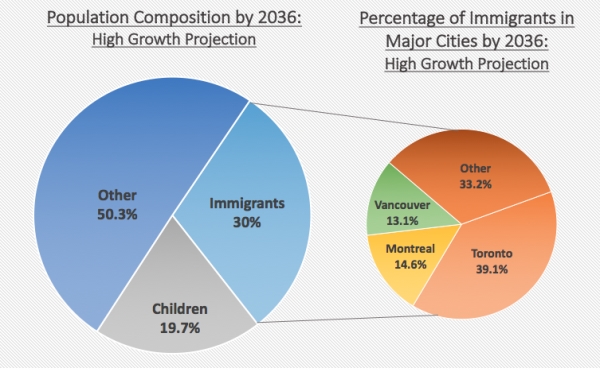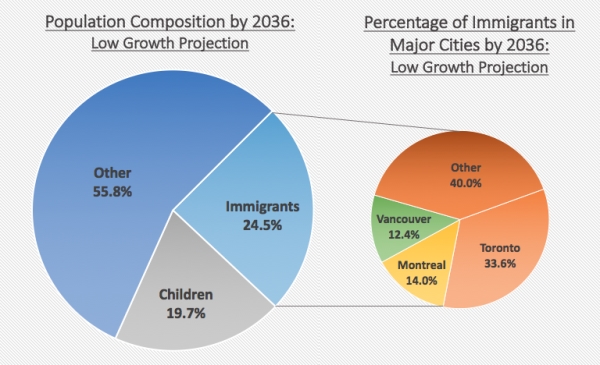Nearly Half of Canada’s Population May be Immigrants and Their Children by 2036
A comprehensive report financed by Immigration, Refugees and Citizenship Canada (IRCC) projects that up to half of the Canadian population could be first generation immigrants and their children by the year 2036.
The study, which was released by Statistics Canada, states that the proportion of immigrants in Canada's population could reach 30 percent by 2036 — compared to 20.7 per cent in 2011 — while around in one in five would be the child of an immigrant, up from 17.5 percent in 2011.
Multiculturalism alive and well
In what may be seen as bucking the global trend, the study projects that the country will continue to embrace diversity and multiculturalism well into the future.
Immigrants from Asia are expected to make up the majority of immigrants in Canada by 2036 (up from 45 percent to between 55 and 58 percent), while the percentage born in Europe would decline to between 15 percent and 18 percent, down from 31.6 percent. The proportion of immigrants from Africa would continue to increase to around 11 percent.
Among the working-age population, the share that belongs to a visible minority group could double from around one in five today to between 35 percent and 40 percent by 2036. South Asian would still be the main visible minority group, as it is today, followed by Chinese. However, the most rapidly growing groups would be the Arab, Filipino and West Asian groups.
Canada would also continue to be a land of many languages. Multilingualism is an everyday reality, and this shows no signs of changing. By 2036, almost 30 per cent of the population (between 10.7 and 13.8 million people) will have a first language other than English or French, though proficiency in these languages continues to be important in professional, social, and academic life in Canada. Indeed, proficiency in one of these languages is a standard requirement for principal applicants to Canada’s economic immigration programs.
Currently, around one in five people in Canada have a first language that is neither English nor French.
The most religiously diverse areas in Canada would remain as such over the next quarter century. Cities such as Toronto, Vancouver, Calgary and Edmonton, which had a large proportion of immigrants among their population in 2011, would continue to be diverse. Indeed, an increasing share of the national population is likely to identify as belonging to no religion.
City living
Based on all projection scenarios, the vast majority of immigrants to Canada will make one of the large cities their new home.
The three primary areas of residence for immigrants would remain Toronto (between 33 and 39 percent), Montreal (around 14 percent) and Vancouver (around 13 percent). Other cities across the country, including Calgary, Edmonton, Winnipeg and others, are also likely to see a higher share of immigrants among their populations than they do today.
The report lays out projections under both high growth and low growth scenarios. In the high growth scenario, which assumes a gradual increase in Canada’s annual immigration target numbers, would see immigrants and their children make up nearly half the population. Under this scenario, the following proportions of immigrants would populate Canada’s major cities.

The low growth scenario, which assumes an unlikely decrease in Canada’s annual immigration target levels, brings about the following projections.

According to all the scenarios, by 2036 the vast majority of people in Toronto — potentially up to 81.4 percent — would be an immigrant or the child of an immigrant, up from 74 percent in 2011. In Vancouver, this share can be expected to reach between 69 and 74 percent.
“This extensive report, which I would encourage anybody with an interest in the future of Canada to take a look at, shows that Canada is capable of welcoming many more immigrants that may contribute positively to the country,” says Attorney David Cohen.
“Not only will this allow communities to develop and provide economic stimulus, but it will help Canada to become a major player on the world stage. In these uncertain global times, that added advantage would be a huge benefit to Canadians and newcomers to the country alike.”
To find out if you are eligible to immigrate to Canada permanently, fill out a free online assessment form.
The full report is available on the Statistics Canada website. The projections are based on models from the 2011 National Household Survey.
© 2017 CICNews All Rights Reserved
- Do you need Canadian immigration assistance? Contact the Contact Cohen Immigration Law firm by completing our form
- Send us your feedback or your non-legal assistance questions by emailing us at media@canadavisa.com







